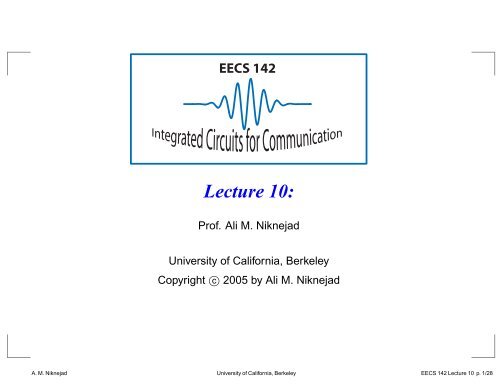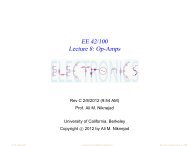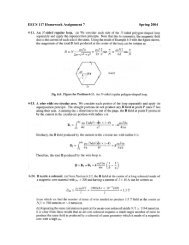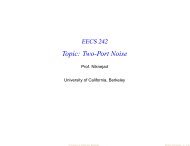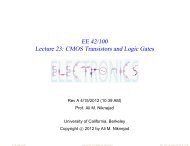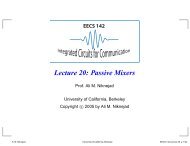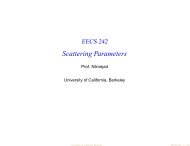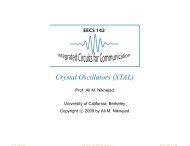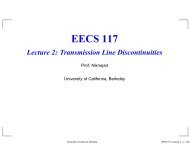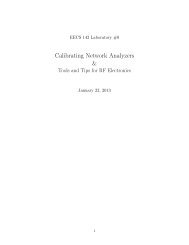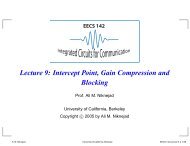EECS 142 Lecture 10 - Ali M. Niknejad - University of California ...
EECS 142 Lecture 10 - Ali M. Niknejad - University of California ...
EECS 142 Lecture 10 - Ali M. Niknejad - University of California ...
- No tags were found...
You also want an ePaper? Increase the reach of your titles
YUMPU automatically turns print PDFs into web optimized ePapers that Google loves.
<strong>EECS</strong> <strong>142</strong><strong>Lecture</strong> <strong>10</strong>:Pr<strong>of</strong>. <strong>Ali</strong> M. <strong>Niknejad</strong><strong>University</strong> <strong>of</strong> <strong>California</strong>, BerkeleyCopyright c○ 2005 by <strong>Ali</strong> M. <strong>Niknejad</strong>A. M. <strong>Niknejad</strong> <strong>University</strong> <strong>of</strong> <strong>California</strong>, Berkeley <strong>EECS</strong> <strong>142</strong> <strong>Lecture</strong> <strong>10</strong> p. 1/28
N Tones in One ShotConsider the effect <strong>of</strong> an m’th order non-linearity on aninput <strong>of</strong> N tonesy m =( N ∑n=1A n cos ω n t) my m =( N ∑n=1y m =A n2( N∑n=−N(eω n t + e −ω nt )) mA n2 eω nt) mwhere we assumed that A 0 ≡ 0 and ω −k = −ω k .A. M. <strong>Niknejad</strong> <strong>University</strong> <strong>of</strong> <strong>California</strong>, Berkeley <strong>EECS</strong> <strong>142</strong> <strong>Lecture</strong> <strong>10</strong> p. 2/28
Product <strong>of</strong> sums...The product <strong>of</strong> sums can be written as lots <strong>of</strong> sums...=N∑k 1 =−N= ∑ () × ∑ () × ∑ () · · · × ∑ ()} {{ }m−timesN∑k 2 =−N· · ·N∑k m =−NA k1 A k2 · · ·A km2 m ×e j(ω k 1+ω k2 +···+ω k m)tNotice that we generate frequency componentω k1 + ω k2 + · · · + ω km , sums and differences between mnon-distinct frequencies.There are a total <strong>of</strong> (2N) m terms.A. M. <strong>Niknejad</strong> <strong>University</strong> <strong>of</strong> <strong>California</strong>, Berkeley <strong>EECS</strong> <strong>142</strong> <strong>Lecture</strong> <strong>10</strong> p. 3/28
ExampleLet’s take a simple example <strong>of</strong> m = 3, N = 2. Wealready know that this cubic non-linearity will generateharmonic distortion and IM products.We have (2N) m = 4 3 = 64 combinations <strong>of</strong> complexfrequencies. ω ∈ {−ω 2 , −ω 1 ,ω 1 ,ω 2 }. There are 64 termsthat looks like this (HD 3 )(IM3)ω 1 + ω 1 + ω 1 = 3ω 1ω 1 + ω 1 + ω 2 = 2ω 1 + ω 2ω 1 + ω 1 − ω 2 = 2ω 1 − ω 2(Gain compression or expansion)ω 1 + ω 1 − ω 1 = ω 1A. M. <strong>Niknejad</strong> <strong>University</strong> <strong>of</strong> <strong>California</strong>, Berkeley <strong>EECS</strong> <strong>142</strong> <strong>Lecture</strong> <strong>10</strong> p. 4/28
Frequency Mix VectorLet the vector ⃗ k = (k −N , · · · ,k −1 ,k 1 , · · · ,k N ) be a2N-vector where element k j denotes the number <strong>of</strong>times a particular frequency appears in a given term.As an example, consider the frequency terms⎫ω 2 + ω 1 + ω 2 ⎪⎬ω 1 + ω 2 + ω 2⃗ k = (0, 0, 1, 2)⎪ω 2 + ω 2 + ω ⎭1A. M. <strong>Niknejad</strong> <strong>University</strong> <strong>of</strong> <strong>California</strong>, Berkeley <strong>EECS</strong> <strong>142</strong> <strong>Lecture</strong> <strong>10</strong> p. 5/28
Properties <strong>of</strong> ⃗ kFirst it’s clear that the sum <strong>of</strong> the k j must equal mN∑j=−Nk j = k −N + · · · + k −1 + k 1 + · · · + k N = mFor a fixed vector ⃗ k 0 , how many different sum vectorsare there?We can sum m frequencies m! ways. But the order <strong>of</strong>the sum is irrelevant. Since each k j coefficient can beordered k j ! ways, the number <strong>of</strong> ways to form a givenfrequency product is given by(m; ⃗ k) =m!(k −N )! · · · (k −1 )!(k 1 )! · · · (k N )!A. M. <strong>Niknejad</strong> <strong>University</strong> <strong>of</strong> <strong>California</strong>, Berkeley <strong>EECS</strong> <strong>142</strong> <strong>Lecture</strong> <strong>10</strong> p. 6/28
Extraction <strong>of</strong> Real SignalSince our signal is real, each term has a complexconjugate present. Hence there is another vector ⃗ k ′ 0given by⃗k ′ 0 = (k N, · · · ,k 1 ,k −1 , · · · ,k −N )Notice that the components are in reverse order sinceω −j = −ω j . If we take the sum <strong>of</strong> these two terms wehave{}2R e j(ω k 1+ω k2 +···+ω k m)t= 2 cos(ω k1 + ω k2 + · · · + ω km )tThe amplitude <strong>of</strong> a frequency product is thus given by2 × (m; ⃗ k)2 m = (m;⃗ k)2 m−1A. M. <strong>Niknejad</strong> <strong>University</strong> <strong>of</strong> <strong>California</strong>, Berkeley <strong>EECS</strong> <strong>142</strong> <strong>Lecture</strong> <strong>10</strong> p. 7/28
Example: IM 3 AgainUsing this new tool, let’s derive an equation for the IM 3product more directly.Since we have two tones, N = 2. IM 3 is generated by am = 3 non-linear term.A particular IM 3 product, such as (2ω 1 − ω 2 ), isgenerated by the frequency mix vector ⃗ k = (1, 0, 2, 0).(m; ⃗ k) = 3!1! · 2! = 3 2 m−1 = 2 2 = 4So the amplitude <strong>of</strong> the IM 3 product is 3/4a 3 s 3 i . Relativeto the fundamentalIM 3 = 3 4a 3 s 3 ia 1 s i= 3 4a 3a 1s 2 iA. M. <strong>Niknejad</strong> <strong>University</strong> <strong>of</strong> <strong>California</strong>, Berkeley <strong>EECS</strong> <strong>142</strong> <strong>Lecture</strong> <strong>10</strong> p. 8/28
Harder Example: Pentic Non-LinearityLet’s calculate the gain expansion/compression due tothe 5th order non-linearity. For a one tone, we haveN = 1 and m = 5.A pentic term generates fundamental as followsω 1 + ω 1 + ω 1 − ω 1 − ω 1 = ω 1In terms <strong>of</strong> the ⃗ k vector, this is captured by ⃗ k = (2, 3).The amplitude <strong>of</strong> this term is given by(m; ⃗ k) = 5!2! · 3! = 5 · 42= <strong>10</strong> 2 m−1 = 2 4 = 16So the fundamental amplitude generated is a 5<strong>10</strong>16 S5 i .A. M. <strong>Niknejad</strong> <strong>University</strong> <strong>of</strong> <strong>California</strong>, Berkeley <strong>EECS</strong> <strong>142</strong> <strong>Lecture</strong> <strong>10</strong> p. 9/28
Apparent Gain Due to PenticThe apparent gain <strong>of</strong> the system, including the 3rd and5th, is thus given byAppGain = a 1 + 3 4 a 3S 2 i + <strong>10</strong>16 a 5S 4 iAt what signal level is the 5th order term as large as the3rd order term?34 a 3Si 2 = <strong>10</strong>√16 a 5Si 4 S i = 1.2 a 3a 5For a bipolar amplifier, we found that a 3 = 1/(3!Vt 3)anda 5 = 1/(5!Vt 5).Solving for S i, we haveS i = V t√1.2 × 5 × 4 ≈ 127 mVA. M. <strong>Niknejad</strong> <strong>University</strong> <strong>of</strong> <strong>California</strong>, Berkeley <strong>EECS</strong> <strong>142</strong> <strong>Lecture</strong> <strong>10</strong> p. <strong>10</strong>/28
Effect <strong>of</strong> Feedback on Distoss ǫ si + a <strong>of</strong>We usually implement the feedback with a passivenetworkAssume that the only distortion is in the forward path as o = a 1 s ǫ + a 2 s 2 ǫ + a 3 s 3 ǫ + · · ·s ǫ = s i − fs os o = a 1 (s i − fs o ) + a 2 (s i − fs o ) 2 + a 3 (s i − fs o ) 3 + · · ·A. M. <strong>Niknejad</strong> <strong>University</strong> <strong>of</strong> <strong>California</strong>, Berkeley <strong>EECS</strong> <strong>142</strong> <strong>Lecture</strong> <strong>10</strong> p. 11/28
Feedback and Disto (cont)We’d like to ultimately derive an equation as followss o = b 1 s i + b 2 s 2 i + b 3 s 3 i + · · ·Substitute this solution into the equation to obtainb 1 s i + b 2 s 2 i + b 3 s 3 i + · · · = a 1 (s i − fb 1 s i − fb 2 s 2 i − · · · )Solve for the first order terms+ a 2 (b 1 s i + b 2 s 2 i + b 3 s 3 i + · · · ) 2+ a 3 (b 1 s i + b 2 s 2 i + b 3 s 3 i + · · · ) 3 + · · ·b 1 s i = a 1 (s i − fb 1 s i )b 1 = a 11 + a 1 f = a 11 + TA. M. <strong>Niknejad</strong> <strong>University</strong> <strong>of</strong> <strong>California</strong>, Berkeley <strong>EECS</strong> <strong>142</strong> <strong>Lecture</strong> <strong>10</strong> p. 12/28
Feedback and Disto (square)The above equation is the same as linear analysis (loopgain T = a 1 f)Now let’s equate second order termsb 2 s 2 i = −a 1 fb 2 s 2 i + a 2 (s i − fb 1 s i ) 2b 2 (a + a 1 f) = a 2(1 − fa 11 + T) 2b 2 (1 + T) 3 = a 2 (1 + T − T) 2 = a 2b 2 =a 2(1 + T) 3Same equation holds at high frequency if we replacewith T(jω)A. M. <strong>Niknejad</strong> <strong>University</strong> <strong>of</strong> <strong>California</strong>, Berkeley <strong>EECS</strong> <strong>142</strong> <strong>Lecture</strong> <strong>10</strong> p. 13/28
Feedback and Disto (cube)Equating third-order termsb 3 s 3 i = a 1 (−fb 3 s 3 i) + a 2 (−fb 2 2s 3 i ) + a 3 (s i − fb 1 s i ) 3 + · · ·b 3 (1 + a 1 f) = −2a 2 b 2 fb 3 (1 + T) = −2a 2f1 + T11 + T + a 3(1 + T) 3a 2(1 + T) 3 + a 3(1 + T) 3b 3 = a 3(1 + a 1 f) − 2a 2 2 f(1 + a 1 f) 5A. M. <strong>Niknejad</strong> <strong>University</strong> <strong>of</strong> <strong>California</strong>, Berkeley <strong>EECS</strong> <strong>142</strong> <strong>Lecture</strong> <strong>10</strong> p. 14/28
Second Order InteractionThe term 2a 2 2f is the second order interactionSecond order disto in fwd path is fed back andcombined with the input linear terms to generate thirdorder distoCan get a third order null ifa 3 (1 + a 1 f) = 2a 2 2fA. M. <strong>Niknejad</strong> <strong>University</strong> <strong>of</strong> <strong>California</strong>, Berkeley <strong>EECS</strong> <strong>142</strong> <strong>Lecture</strong> <strong>10</strong> p. 15/28
HD 2 in Feedback AmpHD 2 = 1 2b 2b 2 s om1= 1 2a 2 (1 + T) 2(1 + T) 3 a 2 s om1= 1 2a 2a 2 1s om1 + TWithout feedback HD 2 = 1 2 a 2a 2 1s omFor a given output signal, the negative feedbackreduces the second order distortion by 11+TA. M. <strong>Niknejad</strong> <strong>University</strong> <strong>of</strong> <strong>California</strong>, Berkeley <strong>EECS</strong> <strong>142</strong> <strong>Lecture</strong> <strong>10</strong> p. 16/28
HD 3 in Feedback AmpHD 3 = 1 4b 3b 3 s 2 om1= 1 4a 3 (1 + T) − 2a 2 2 f(1 + T) 5 (1 + T) 3a 3= 1 4 a 3 s 2 om} {{1}disto with no fb11 + Ta 3 1s 2 om[1 − 2a2 2 fa 3 (1 + T)]A. M. <strong>Niknejad</strong> <strong>University</strong> <strong>of</strong> <strong>California</strong>, Berkeley <strong>EECS</strong> <strong>142</strong> <strong>Lecture</strong> <strong>10</strong> p. 17/28
Feedback versus Input Attenuations ifs o1as oNotice that the distortion is improved for a given outputsignal level. Otherwise we can see that simplydecreasing the input signal level improves the distortion.Say s o1 = fs i with f < 1. Thens o = a 1 s o1 +a 2 s 2 o1+a 3 s 3 o1+· · · = a 1 f s}{{} i +a 2 f 2 s}{{}2 i+a 3 f 3 s}{{}3 i+· · ·b 1 b 2 b 3But the distortion is unchanged for a given output signalHD 2 = 1 2b 2b 2 1s om = 1 2a 2a 2 s om1A. M. <strong>Niknejad</strong> <strong>University</strong> <strong>of</strong> <strong>California</strong>, Berkeley <strong>EECS</strong> <strong>142</strong> <strong>Lecture</strong> <strong>10</strong> p. 18/28
BJT With Emitter DegenerationI CThe total input signal applied tothe base <strong>of</strong> the amplifier isv iV QR Ev i + V Q = V BE + I E R EThe V BE and I E terms can be split into DC and ACcurrents (assume α ≈ 1)v i + V Q = V BE,Q + v be + (I Q + i c )R ESubtracting bias terms we have a separate AC and DCequationV Q = V BE,Q + I Q R Ev i = v be + i C R EA. M. <strong>Niknejad</strong> <strong>University</strong> <strong>of</strong> <strong>California</strong>, Berkeley <strong>EECS</strong> <strong>142</strong> <strong>Lecture</strong> <strong>10</strong> p. 19/28
Feedback InterpretationThe AC equation can be put into the following formv be = v i − i c R ECompare this to our feedback equations ǫ = s i − fs oThe equations have the same form with the followingsubstitutionss ǫ = v bes o = i cs i = v if = R EA. M. <strong>Niknejad</strong> <strong>University</strong> <strong>of</strong> <strong>California</strong>, Berkeley <strong>EECS</strong> <strong>142</strong> <strong>Lecture</strong> <strong>10</strong> p. 20/28
BJT with Emitter Degen (II)Now we know thati c = a 1 v be + a 2 v 2 be + a 3v 3 be + · · ·where the coefficients a 1,2,3,··· come from expanding theexponential into a Taylor seriesa 1 = g m a 2 = 1 2I QV 2t· · ·With feedback we havei c = b 1 v i + b 2 v 2 i + b 3 v 3 i + · · ·A. M. <strong>Niknejad</strong> <strong>University</strong> <strong>of</strong> <strong>California</strong>, Berkeley <strong>EECS</strong> <strong>142</strong> <strong>Lecture</strong> <strong>10</strong> p. 21/28
Emitter Degeneration (cont)The loop gain T = a 1 f = g m R Eb 1 =g m1 + g m R Eb 2 =(1 q) 22 kT IQ(1 + g m R E ) 3b 3 = · · ·A. M. <strong>Niknejad</strong> <strong>University</strong> <strong>of</strong> <strong>California</strong>, Berkeley <strong>EECS</strong> <strong>142</strong> <strong>Lecture</strong> <strong>10</strong> p. 22/28
Harmonic Distortion with FeedbackUsing our previously derived formulas we haveHD 2 = 1 2b 2b 2 s om1= 1 4î ci q11 + g m R EHD 3 = 1 4b 3b 3 s 2 om1= 1 24(îc) 21 −3g m R E1+g m R EI Q 1 + g m R EA. M. <strong>Niknejad</strong> <strong>University</strong> <strong>of</strong> <strong>California</strong>, Berkeley <strong>EECS</strong> <strong>142</strong> <strong>Lecture</strong> <strong>10</strong> p. 23/28
Harmonic Distortion NullWe can adjust the feedback to obtain a null in HD 3HD 3 = 0 can be achieved with3g m R E1 + g m R E= 1orR E = 12g mA. M. <strong>Niknejad</strong> <strong>University</strong> <strong>of</strong> <strong>California</strong>, Berkeley <strong>EECS</strong> <strong>142</strong> <strong>Lecture</strong> <strong>10</strong> p. 24/28
HD 3 Null ExampleHD 3-40-45-50-55-60-65-700 20 40 60 80 <strong>10</strong>0R E = 12g mR EExample: For I Q = 1mA, R E = 13ΩA. M. <strong>Niknejad</strong> <strong>University</strong> <strong>of</strong> <strong>California</strong>, Berkeley <strong>EECS</strong> <strong>142</strong> <strong>Lecture</strong> <strong>10</strong> p. 25/28
BJT with Finite Source ResistanceR SI Cv iV QR Ev i + V Q − I B R B = V BE + I E R EAssuming that α ≈ 1, β = β 0 (constant). LetR B = R S + r b represent the total resistance at the base.v i + V Q = V BE + I C(R E + R Bβ 0)The formula is the same as the case <strong>of</strong> a BJT withemitter degeneration with R ′ E = R E + R B /β 0A. M. <strong>Niknejad</strong> <strong>University</strong> <strong>of</strong> <strong>California</strong>, Berkeley <strong>EECS</strong> <strong>142</strong> <strong>Lecture</strong> <strong>10</strong> p. 26/28
Emitter FollowerI Cv ov iV QR LThe same equations as beforewith R E = R LA. M. <strong>Niknejad</strong> <strong>University</strong> <strong>of</strong> <strong>California</strong>, Berkeley <strong>EECS</strong> <strong>142</strong> <strong>Lecture</strong> <strong>10</strong> p. 27/28
Common Basev iR EI CR LV QV CCSame equation as CE with R E feedbackv i − V Q + I C R E = −V BEA. M. <strong>Niknejad</strong> <strong>University</strong> <strong>of</strong> <strong>California</strong>, Berkeley <strong>EECS</strong> <strong>142</strong> <strong>Lecture</strong> <strong>10</strong> p. 28/28


